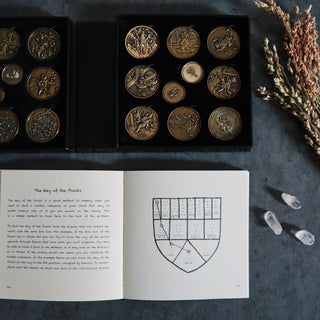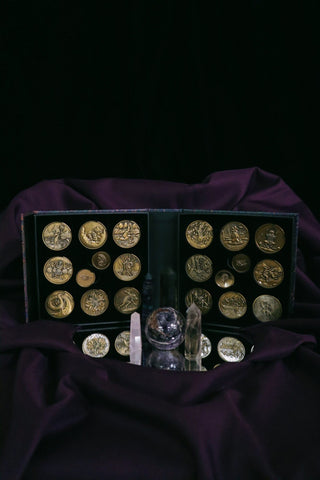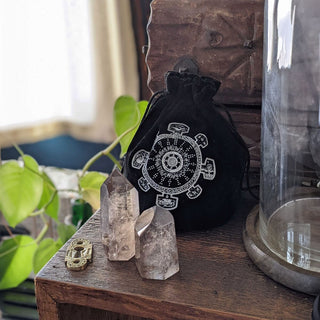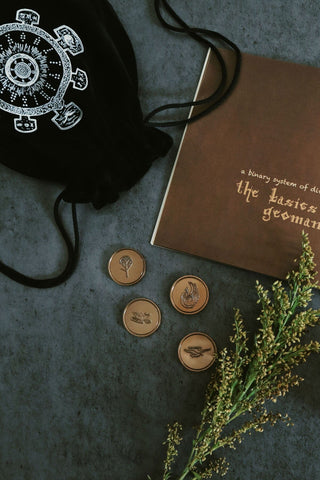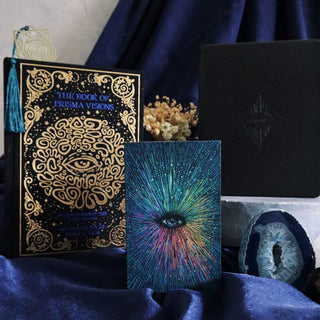Who are the Geomantic Figures?
The 16 geomantic figures have remained the same throughout time. The names have been adapted to different languages but the root meaning of each is the same. In this guide, we will be using the original Latin names. Each figure is associated with an astrological sign, a planet, an elemental structure, the physical attributes of a person, and a part of the body.
What is interesting about geomancy that is unlike most other forms of divination, there is no set ordering to the figures. Some Geomancers prefer to order them based on their elemental makeup, while others order them based on their planets or astrological signs. Here we have chosen to order them alphabetically for educational purposes. See below the original form of the figures and the beings we've chosen to associate with each figure.


Each figure has a counterpart or an inversion. Below you will see the counterparts coupled together. Notice that each pattern of dots is either a flipped version of its counterpart or in the case of Carcer and Conjunctio, which are symmetrical figures, their dots are opposites of one another.

What does it all mean?
Acquisitio and Amissio
Acquisitio stands for “gain” and Amissio stands for “loss”. You can see that Acquisitio is the opposite formation of Amissio.
Rubeus and Albus
Rubeus, or “the red” stands for many dark things and is the opposite of Albus, or “the white” which represents peace and illumination. Rubeus is an unfavorable figure in most cases and can be seen as violent and often chaotic. On the other hand Albus is a fortunate figure of wisdom, but is weak and passive.
Carcer and Conjunctio
Carcer stands for “incarceration” and Conjunctio stands for “connection”. These figures are met in balance as they both deal with mobility and growth. Carcer represents being stuck in one place whereas Conjunctio represents where two paths or people meet together.
Fortuna Major and Fortuna Minor
Both of these figures deal with success and fortune. Fortuna Minor represents temporary good fortune, but something that over time will not last, whereas Fortuna Major stands for great stable fortune.
Tristitia and Laetitia
Tristitia stands for “sorrow” and Laetitia, a very favorable figure, stands for “joy”.
Caput Draconis and Cauda Draconis
Caput Draconis, or “the head of the dragon” represents beginnings while Cauda Draconis, or “the tail of the dragon” represents endings.
Puer and Puella
Puer, or “the boy” represents male energy and is unbalanced and aggressive. In opposition, we have Puella, or “the girl” which represents female energy and harmony.
Populus and Via
Populus, or “the people” is the most passive figure simply represents a lot of something, whereas Via, or “the way” is the most active figure and represents change and movement forward.
The beings on the coins have been chosen to reflect each geomantic figure's significance making them a great tool for learning. Study the illustrations on the coins alongside the meanings of each figure and look for clues that signify what they represent. For example, Caput Draconis, a figure representing beginnings is Latin for "dragon's head". The being on this coin is depicted at the start of a path and dons a dragon's head. Aside from being used to determine the four mothers at the start of your shield, or as a general learning tool, the geomantic figures on their own, carry a lot of power- for this reason, they can be used as talismans as well. Carefully select the figure you wish to evoke and carry it with you to manifest its power.
In the following blog post, we will discuss what the favorable and unfavorable figures are, as well as the stable and unstable ones in order to determine the answers you seek.

